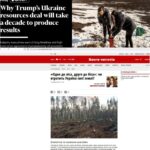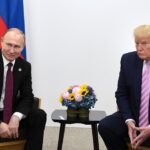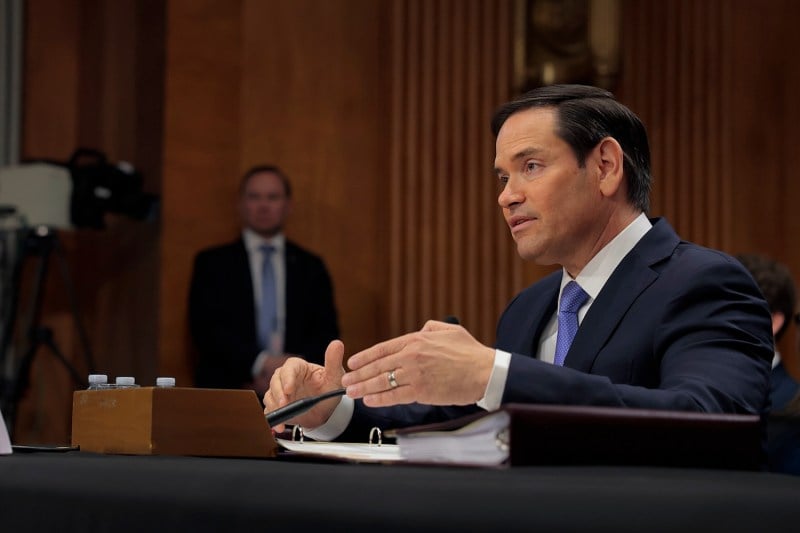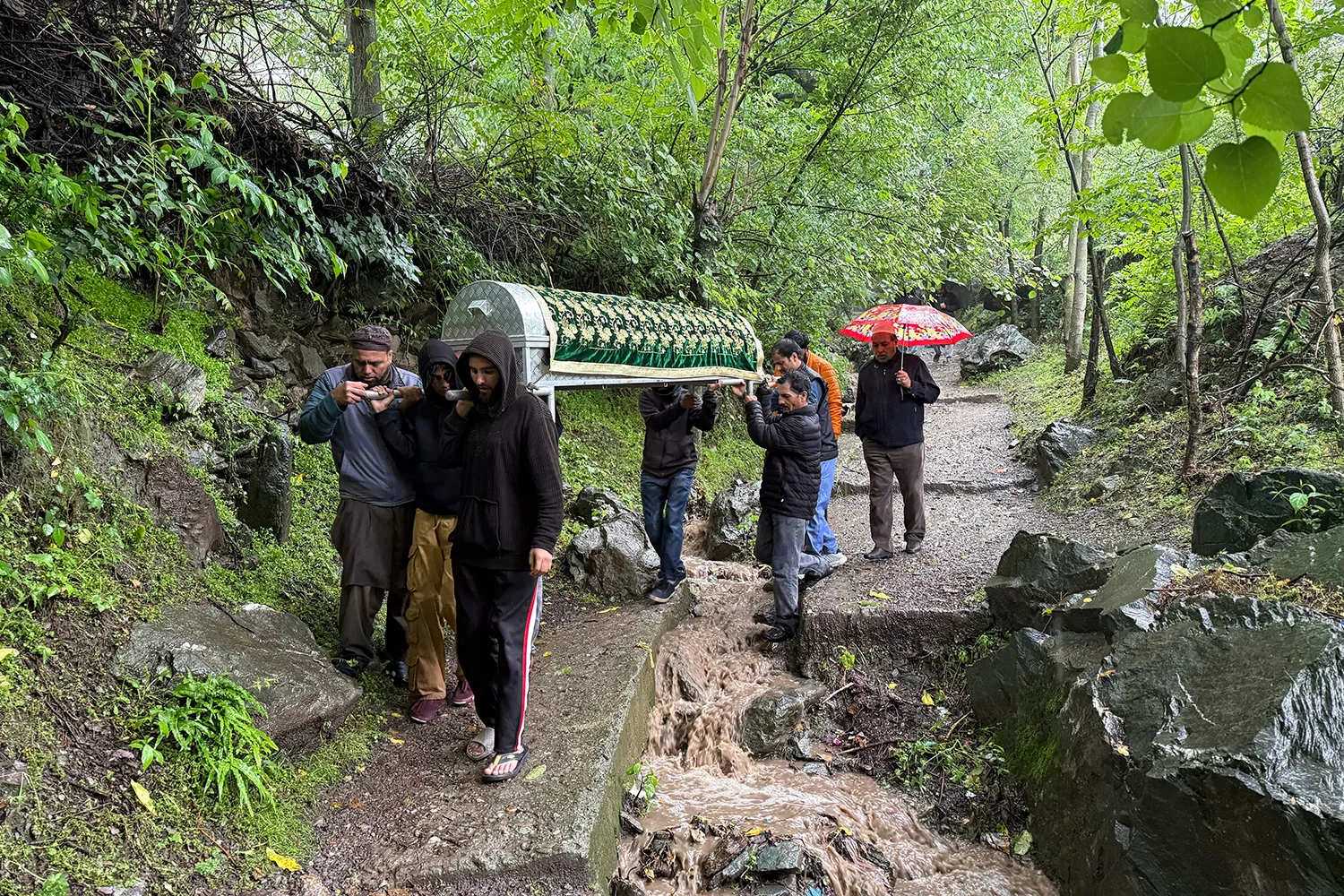India Faces High Stakes in U.S. Trade Talks

India Faces High Stakes in U.S. Trade Talks
The negotiations are especially urgent for New Delhi as it will be hit hard by Trump’s reciprocal tariffs.
U.S. President Donald Trump and Indian Prime Minister Narendra Modi hold a joint press conference in the White House in Washington on Feb. 13. Andrew Caballero-Reynolds/AFP via Getty Images
Welcome to Foreign Policy’s South Asia Brief.
The highlights this week: U.S. and Indian officials conclude a first round of trade talks as U.S. President Donald Trump announces new global tariffs, India quickly dispatches humanitarian aid to Myanmar in the wake of a devastating earthquake, and comments from Bangladeshi leader Muhammad Yunus in Beijing stir controversy in New Delhi.
Welcome to Foreign Policy’s South Asia Brief.
The highlights this week: U.S. and Indian officials conclude a first round of trade talks as U.S. President Donald Trump announces new global tariffs, India quickly dispatches humanitarian aid to Myanmar in the wake of a devastating earthquake, and comments from Bangladeshi leader Muhammad Yunus in Beijing stir controversy in New Delhi.
U.S., India Talk Trade as New Tariffs Hit
U.S. and Indian officials concluded an initial round of discussions on a bilateral trade deal in New Delhi over the weekend. Talks regarding specific sectors are expected in the next few weeks. The two countries committed to pursuing a deal in February, after Indian Prime Minister Narendra Modi met U.S. President Donald Trump in Washington.
The time frame is tight, with an agreement on the first phase of a trade agreement targeted for the fall. The stakes are high for India, and reaching a deal will be a major test of New Delhi’s negotiating prowess. Trade negotiations are especially urgent for India because they are playing out against Washington’s new reciprocal tariffs, which Trump was expected to unveil on Wednesday.
The levies could hit India hard: The country has a nearly $50 billion trade deficit with the United States in its favor. New Delhi’s tariff rates are among the world’s highest; on average, it currently charges more than 10 percent more on U.S. imports than the United States charges on Indian imports. Trump has repeatedly singled out India as a tariff offender.
The U.S.-India trade deal is intended to reduce both tariff and nontariff barriers, meaning that reaching an agreement could help blunt the effects of any new U.S. duties on India’s economy.
India, despite having the world’s fastest-growing major economy, faces stress in key industries. According to government data released in February, growth rates in manufacturing, construction, and services in the last quarter of 2024 were significantly lower than during the same period in 2023. Failing to ink a deal that softens the impact of U.S. tariffs could bring more pain to India’s private sector.
However, the trade talks will be a slog. India has already committed to increasing imports of U.S. goods, but important Indian economic considerations—such as the continued availability of cheap Russian oil and the expense of U.S. arms packages—might make New Delhi unwilling to purchase as much as Washington would like.
There are also domestic political risks for New Delhi. Indian tariff disparities are especially wide for agricultural products. But India will be reluctant to loosen protections in the sector, given that farmers are a critical constituency. Mass farmers’ protests in 2021 prompted Indian Modi to pull back agricultural liberalization laws in a rare policy reversal.
Modi’s predecessor, Manmohan Singh, staked his political survival on a civil nuclear deal with the United States that leftist parties in his coalition bitterly opposed. Modi’s predicament is less serious: His coalition partners likely won’t resist a trade deal with Washington, and he is more popular than Singh ever was.
But Modi still risks some public backlash, especially if his government—which projects itself as confident and nationalistic—seemingly bends over backward to appease Washington with pledges to reduce tariffs, import more U.S. goods, and take back undocumented Indians who are deported from the United States.
India certainly has leverage to wield in the talks. It can point to its recent track record: increasing U.S. imports by $3 billion from 2017 to 2023 and investing $40 billion in the United States in recent years. At the same time, New Delhi is moving preemptively to fortify its economy. In February, the Reserve Bank of India—likely buoyed by falling inflation—lowered interest rates for the first time in nearly five years in an effort to spur more private-sector growth.
The United States and India are close commercial partners, and they ultimately want trade talks to succeed. Washington will likely recognize the strategic risks of a failed deal, which could include New Delhi capitalizing on its recent thaw with Beijing to scale up economic ties with China—thereby undercutting U.S.-India efforts to counter Chinese economic clout.
Still, the trade talks serve a reminder to the Indian government—which has telegraphed its comfort level with engaging with Trump—that Washington’s new approach means new challenges for many of its closest partners.
What We’re Following
India sends aid to Myanmar. India moved quickly to dispatch humanitarian assistance to neighboring Myanmar in the wake of a devastating earthquake last week. New Delhi has sent food and other relief aid, a search and rescue team, and medical workers. In addition to a simple desire to help its neighbor, India has a practical reason to chip in: It wants to help reduce the risk that the aftermath of the earthquake further destabilizes Myanmar.
India derives some strategic value from showcasing that it can play a prominent role in global response efforts, as it is keen to push back against the idea that it punches below its weight on the world stage. New Delhi’s recent emergence as a net security provider undercuts that potential criticism, but positioning itself prominently in relief efforts helps its cause, too.
Yunus comments spark controversy. Bangladesh’s interim leader, Muhammad Yunus, returned to Dhaka over the weekend after a four-day visit to China. Officials in New Delhi watched the trip closely; India has been uncomfortable with developments in Bangladesh since its close ally and longtime Prime Minister Sheikh Hasina resigned under pressure last year.
The main outcomes of Yunus’s trip, including the signing of more than a dozen agreements and memorandums of understanding focused on culture and economics, likely didn’t upset India much. However, a comment that Yunus made while in China—which the interim government only publicized this week—has stirred controversy in India.
Yunus said that because northeast India is landlocked, Bangladesh is the “only guardian of the ocean for all this region”—an apparent reference to the parts of the Bay of Bengal to the south of Bangladesh—and added that this creates opportunities for economic cooperation between Bangladesh and China.
Because Bangladesh bisects India, separating its volatile northeast from the rest of the country, the region plays a critical role in India-Bangladesh relations. New Delhi hasn’t publicly reacted to the comment, but there may be an opportunity to clear the air this week. Yunus and Modi are likely to meet in person—for the first time since Yunus took office—at a regional conference in Bangkok.
Nepal pro-Monarchy protests turn violent. Last Friday, a protest calling for the restoration of Nepal’s monarchy in Kathmandu descended into violence, with two people killed and dozens more injured. Protesters reportedly ran through police barricades, threw stones at officers, and vandalized buildings, prompting law enforcement to respond with tear gas.
Nepal has seen surges in support for restoring the monarchy, which was abolished in 2008, amid increasing public disaffection with the political class due to corruption and its failure to address economic stress. But despite some large protests, such sentiment has not morphed into a mass movement.
Nepal’s government has largely shrugged off pro-royalist sentiment, though the latest unrest could prompt concern about security. Future pro-monarchy protests may prompt crackdowns by the authorities. Several protesters last Friday described their activism less as a genuine desire to see the monarchy return and more as an expression of anger against the political system.
FP’s Most Read This Week
- Asia Is Getting Dangerously Unbalanced by Stephen M. Walt
- What Would a Military Strike on Iran Mean for the Middle East? by Mahsa Rouhi, Aziz Alghashian, and Saeid Jafari
- The U.S. Judicial Crisis Is Uniquely Dangerous by Andrew O’Donohue
Under the Radar
Sanjay Raut, a leader from India’s Shiv Sena (UBT) party, made a surprising claim on Monday: that Modi visited the Maharashtra headquarters of Rashtriya Swayamsevak Sangh, the powerful Hindu nationalist organization with deep ties to the ruling Bharatiya Janata Party (BJP), to discuss his retirement from politics.
The regional Shiv Sena (UBT) party is also based in the state of Maharashtra but is aligned on the national level with the INDIA opposition alliance; Raut said that Modi’s successor would come from the state. The Maharashtra chief minister, Devendra Fadnavis of the BJP, rejected Raut’s assertion and said that Modi isn’t retiring.
It’s unclear why Raut would make such a comment, other than to be a nuisance to the BJP. The original Shiv Sena party was ideologically aligned with the BJP, but it split into smaller groups in 2022; Raut’s faction sees the ruling party as a rival.
India has no term limits for prime ministers, and there is no maximum age for politicians to hold office. Modi turns 75 in September and is poised to run for a fourth term in 2029. But Raut’s focus on the prime minister’s political future hit on one of the more sensitive questions in Indian politics: Who will replace Modi when he finally decides to retire?
Indian Interior Minister Amit Shah—the BJP’s No. 2 official—and Uttar Pradesh Chief Minister Yogi Adityanath are among the contenders; there are potential dark horse candidates, such as Transport Minister Nitin Gadkari. Though Fadnavis isn’t usually mentioned, Raut’s comments—even if inaccurate—could prompt speculation about his name.
Michael Kugelman is the writer of Foreign Policy’s weekly South Asia Brief. He is the director of the South Asia Institute at the Wilson Center in Washington. X: @michaelkugelman
More from Foreign Policy
-

An illustration shows a golden Cybertruck blasting through a U.S. seal of an eagle holding arrows and laurel. Is America a Kleptocracy?
Here’s how life could change for the rich, poor, and everyone in between.
-

The flag of the United States in New York City on Sept. 18, 2019. America Is Listing in a Gathering Storm
Alarms are clanging at the U.S. geographic military commands around the globe.
-

U.S. President Donald Trump shakes hands with Supreme Court Chief Justice John Roberts during Trump’s inauguration in Washington, D.C. The U.S. Judicial Crisis Is Uniquely Dangerous
But other democracies provide a roadmap for courts to prevail over attacks from the executive branch.
-

An illustration shows a golden Newtons cradle with Elon Musk depicted on the one at left and sending a globe-motif ball swinging at right. Elon Musk’s First Principles
The world’s richest man wants to apply the rules of physics to politics. What could go wrong?










Join the Conversation
Commenting on this and other recent articles is just one benefit of a Foreign Policy subscription.
Already a subscriber?
.
Subscribe
Subscribe
View Comments
Join the Conversation
Join the conversation on this and other recent Foreign Policy articles when you subscribe now.
Subscribe
Subscribe
Not your account?
View Comments
Join the Conversation
Please follow our comment guidelines, stay on topic, and be civil, courteous, and respectful of others’ beliefs.
Change your username |
Log out
Change your username:
CANCEL
Confirm your username to get started.
The default username below has been generated using the first name and last initial on your FP subscriber account. Usernames may be updated at any time and must not contain inappropriate or offensive language.